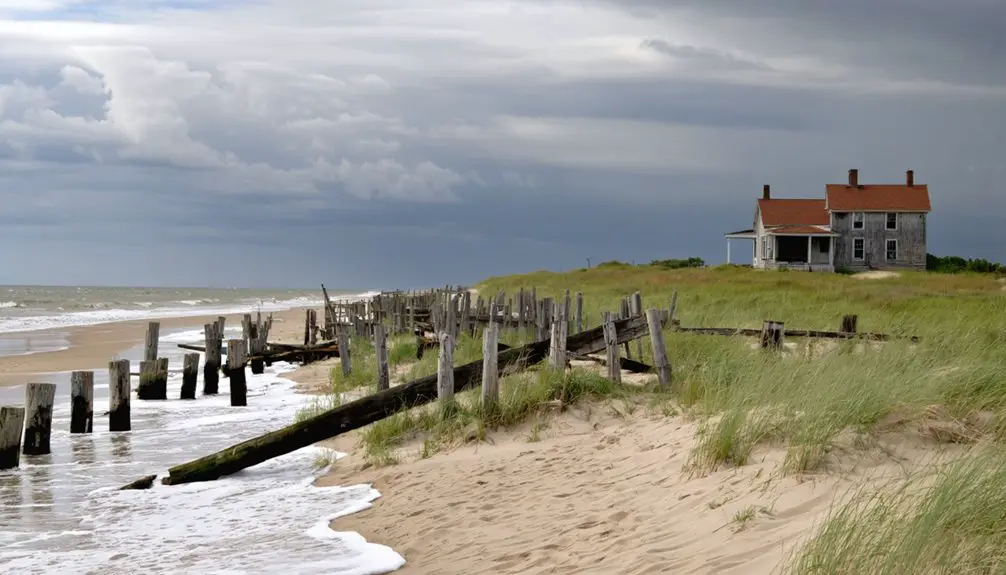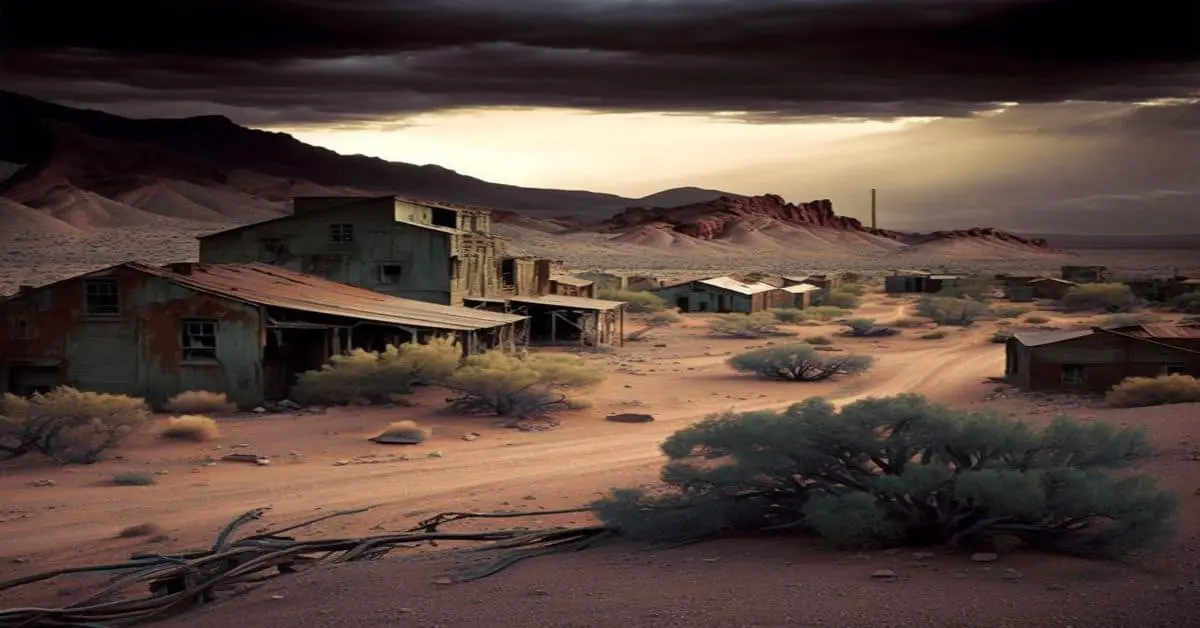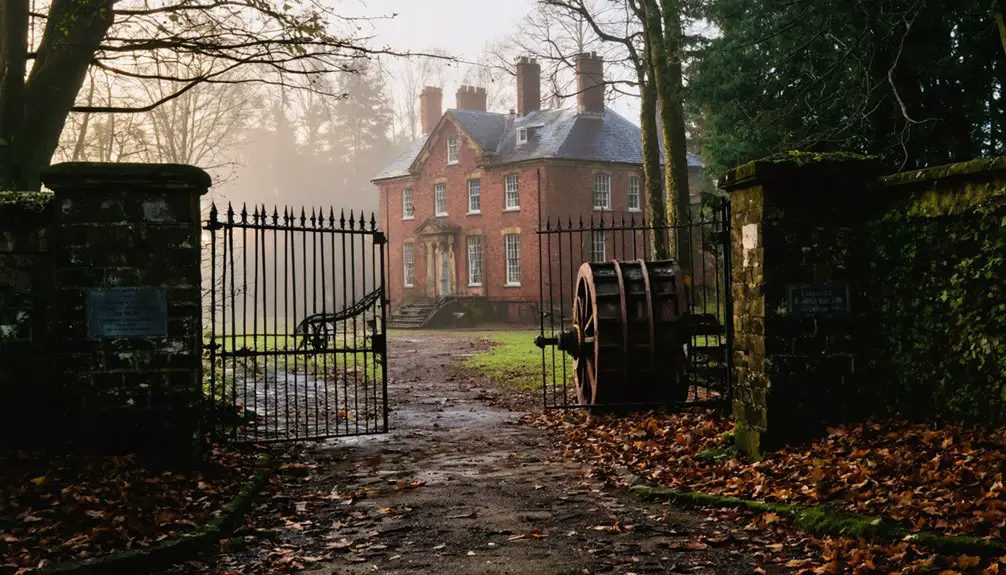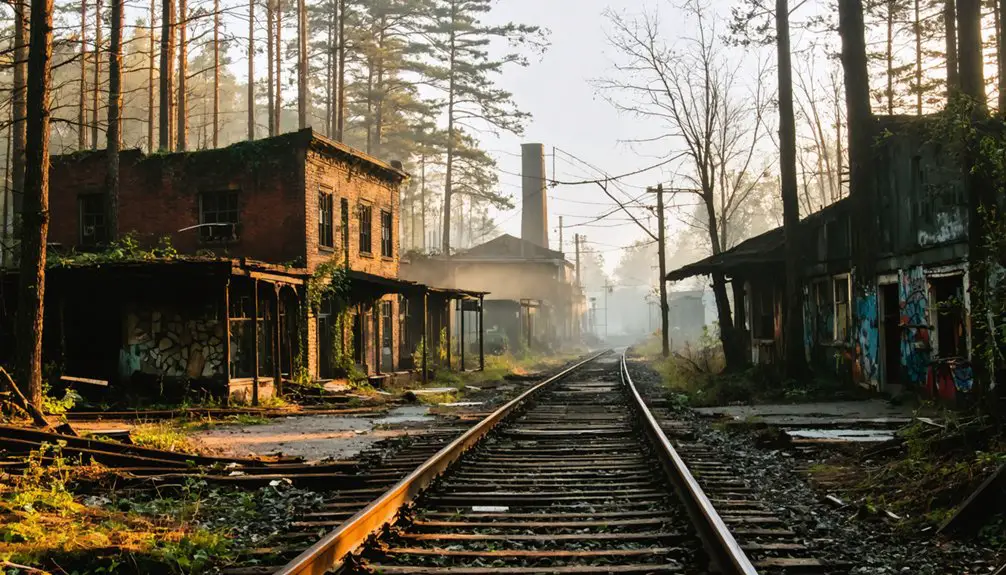You’ll find South Cape May’s story in its vanished Victorian homes and submerged streets, victims of nature’s relentless assault since 1894. Three major storms – the 1936 Nor’easter, 1944 Great Atlantic Hurricane, and 1950’s 88-mph tempest – combined with severe coastal erosion to transform this once-elegant resort borough into marshland. Today, only street signs and local legends mark where a 21-block community stood, while the ocean keeps its secrets beneath the waves.
Key Takeaways
- South Cape May was established in 1894 and developed as a Victorian coastal resort town with 2,500 planned residential lots.
- Three major storms (1936, 1944, 1950) devastated the town, with the Great Atlantic Hurricane of 1944 initiating its decline into abandonment.
- Relentless coastal erosion claimed over 150 acres of shoreline, transforming habitable areas into marshland and forcing residents to relocate.
- Physical remnants include surviving street signs from First and Second Avenues, while Third Avenue lies buried beneath shifting dunes.
- The area is now preserved as wetlands and meadows, with only ghost tours and historical markers maintaining its memory.
The Rise and Fall of a Coastal Borough
While coastal New Jersey saw numerous resort towns emerge in the late 19th century, South Cape May‘s story began on August 27, 1894, when founders Reger and James Henry Edmunds established the borough by withdrawing land from Lower Township.
The West Cape May Improvement Company spearheaded coastal development, implementing a systematic urban planning approach with a gridiron layout accommodating 2,500 lots. Following the tradition of nearby Victorian structures, the developers constructed elegant summer homes along the beachfront.
The area’s promising development included the construction of the Light of Asia, a massive elephant-shaped structure built in 1885 to attract tourists to the growing seaside destination.
Nature’s Devastating Impact
You’ll find few better examples of nature’s raw power than the story of South Cape May, where the Great Atlantic Hurricane of 1944 marked the beginning of the town’s transformation into a ghost town.
The relentless assault of storms, including the devastating “Perfect Storm” of 1991, breached protective dunes and accelerated coastal erosion, claiming over 150 acres of shoreline. The Nature Conservancy recognized the area’s ecological importance and took action by purchasing 200 acres in 1981.
Rising sea levels and intensifying storms continued their march forward, turning the once-thriving borough into brackish marshlands where only the ghosts of former streets and foundations remained. Today’s projections suggest an even grimmer future, with up to 71 inches of sea level rise possible by 2100.
Storms Reshape the Coast
Throughout South Cape May’s history, devastating hurricanes and nor’easters repeatedly transformed the coastal landscape, ultimately leading to the town’s complete abandonment after the Great Atlantic Hurricane of 1944.
You can trace the community’s downfall through a series of relentless storm impacts that tore off rooftops, submerged roads, and compromised home foundations.
The “Perfect Storm” of 1991 demonstrated nature’s continuing fury, inflicting $10 million in damages to Cape May’s beaches.
When additional storms struck in early 1992, they compounded the coastal erosion, breaching protective dunes and causing widespread flooding.
These destructive events racked up $75 million in damages along New Jersey’s coast, forcing both residents and officials to confront the harsh reality of their vulnerable shoreline position.
The Army Corps of Engineers attempted to protect the area in 1913 through beach erosion control measures, but their efforts ultimately proved futile against nature’s power.
The construction of stone jetties in 1911 attempted to block natural sand movement but inadvertently contributed to increased erosion south of the inlet.
Rising Waters Claim Land
Since the early 1960s, South Cape May’s battle against rising waters has intensified through a series of catastrophic floods that permanently reshaped the coastal community.
You’ll find the evidence in devastating events like the 1962 Nor’easter, which pummeled the coast for 60 hours with 15-foot waves, and the record-breaking 1997 flood that dumped 13 inches of rain in just 24 hours. Atlantic County experienced multiple bridges washed out during this historic deluge. The Great Atlantic Hurricane of 1944 led to the complete abandonment of South Cape May.
The peninsula’s vulnerability stems from its low-lying terrain and position where ocean meets tidal creeks.
As flood mitigation efforts struggle to keep pace, you’re witnessing nature’s relentless advance. Rising sea levels and land subsidence have transformed once-habitable areas into marshland, while climate adaptation becomes increasingly essential.
The loss of protective coastal wetlands has only accelerated this transformation, making South Cape May a stark reminder of nature’s power to reclaim developed land.
Ocean’s Relentless March Forward
While South Cape May’s residents fought against rising waters, the Atlantic Ocean’s relentless assault proved insurmountable through multiple devastating mechanisms.
You’d have witnessed powerful ocean currents systematically dismantling the town’s coastal resilience, as waves battered shorelines and storm surges pushed further inland. The area’s geological instability didn’t help – the land itself was sinking while the ocean advanced.
Nature’s forces worked in concert: As protective ecosystems vanished, including essential dune systems and coastal marshes, the town’s vulnerability increased. Many residents relocated to Hotel Macomber’s location, which offered higher ground and better protection from the advancing waters. The area’s haunting reputation grew as ghostly encounters were reported along Jackson Street’s Victorian mansions.
The ocean’s might destroyed natural buffers, while subsidence and groundwater extraction weakened the ground beneath. Despite attempts at ocean conservation and protective measures like seawalls, the combination of fierce Atlantic storms, tidal forces, and deteriorating coastal defenses sealed South Cape May’s fate.
Life Before the Storms
Before devastating storms altered its fate, South Cape May flourished as a modest seaside borough in the late 19th and early 20th centuries. You’d have found a quiet coastal community stretching 21 blocks toward the Cape May lighthouse, where wooden cottages and small businesses lined streets like First and Second Avenue.
Life revolved around seasonal tourism, with local motels and restaurants like the Jetty Motel and Cove Restaurant serving visitors seeking refuge by the sea. You would’ve experienced community gatherings centered on beach activities during summer months, while winters remained peacefully quiet.
The close-knit population fostered simple pleasures, from fishing to local events, creating lasting bonds between generations. Yet beneath this tranquil existence lay vulnerability – the town’s basic infrastructure and wooden buildings stood precariously against nature’s looming threats.
What Remains Today
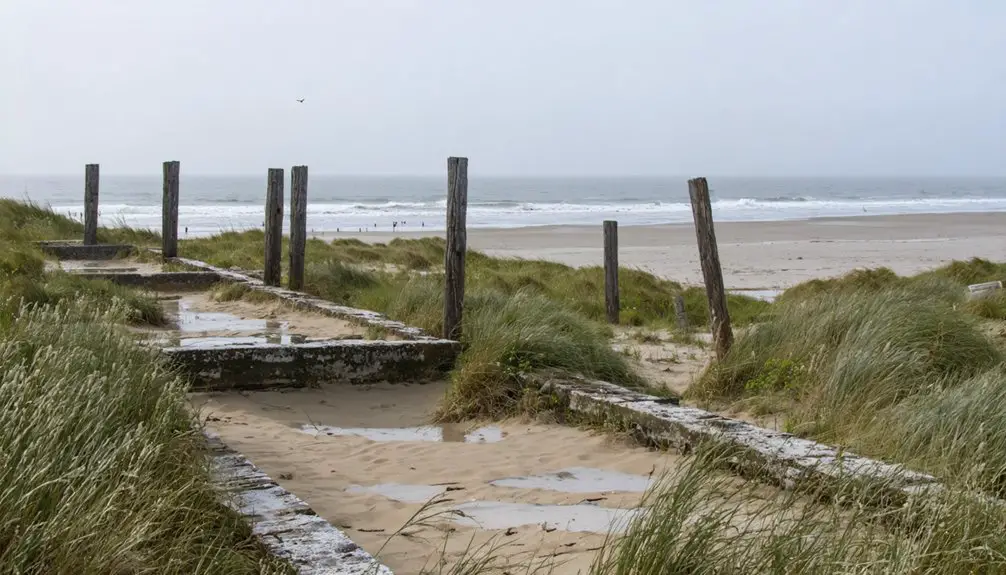
Remnants of South Cape May peek through the coastal landscape today, offering glimpses of its former existence.
You’ll find street signs marking First and Second Avenues, while Third Avenue lies buried beneath shifting dunes. Along Sunset Boulevard, which replaced the old Cape Island Turnpike in 1925, you can explore filled-in land where the town once stood.
The Jetty and Surf Motels, along with the Cove Restaurant, now occupy plots where historic buildings once thrived.
For remnant exploration, you’ll discover the concrete ship “Atlantus” partially submerged nearby – a silent witness to the town’s decline.
While most physical structures have vanished beneath sand and vegetation, the area’s historical significance lives on through local narratives, museum displays, and ghost tours that keep South Cape May’s memory alive.
Environmental Forces at Work
Multiple devastating environmental forces converged to seal South Cape May’s fate. You can trace the town’s demise through three major storms in just 15 years: the 1936 Nor’easter’s gale-force winds that toppled beachfront homes, the 1944 Great Atlantic Hurricane’s devastating floods, and the 1950 storm’s 88-mph winds and massive tidal waves.
The town’s location made it particularly vulnerable – situated on flat, low-lying land with inadequate protection from the Atlantic’s fury. As storms repeatedly breached the dunes, erosion accelerated at rates up to 15 feet per year.
While modern coastal restoration efforts and environmental resilience projects now protect what’s left, they’ve come too late for South Cape May. The once-thriving Victorian resort has transformed into wetlands and meadows, nature reclaiming what humans couldn’t defend.
Tales From the Lost Town
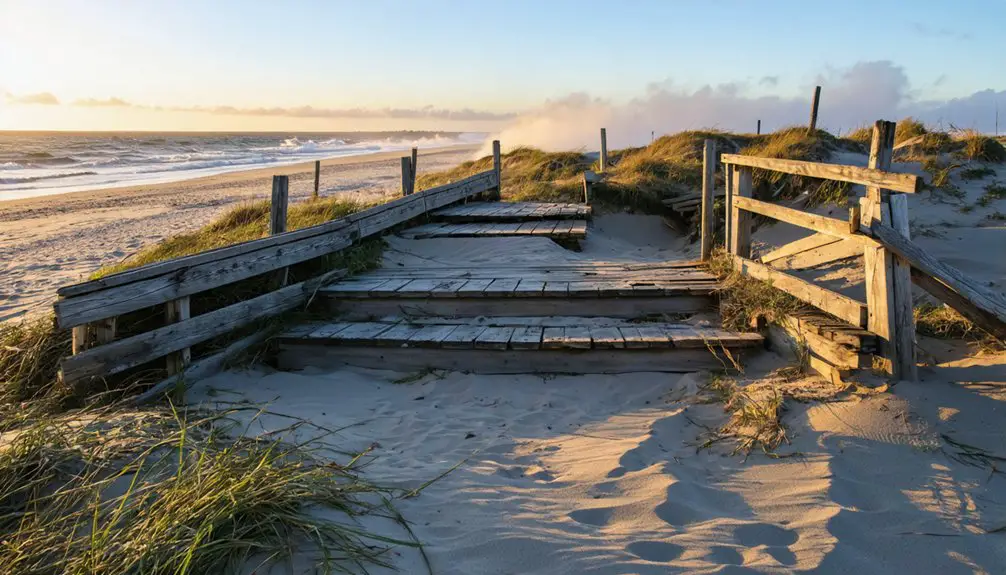
Deep within the transformed landscape of what was once South Cape May, ghostly tales and unexplained phenomena persist despite the town’s physical disappearance.
Phantom whispers echo through South Cape May’s eroded shores, where memories and spirits linger long after waves claimed the town.
You’ll find haunted legends woven through the remnants, where street signs for First and Second Avenue stand sentinel among desolate dunes.
The area’s ghostly sightings extend beyond the lost town into neighboring Cape May, where spirits like the “Lady in Blue” at the Inn of Cape May and Ester Allen at the Southern Mansion continue to make their presence known.
In these historic buildings, you might encounter apparitions of former residents, ill-fated vacationers, and seafarers who’ve never quite departed.
Their stories live on through popular ghost tours that traverse Jackson Street, keeping the memory of South Cape May’s vanished community alive.
Legacy in Local Memory
You’ll still find remnants of South Cape May‘s past in the street names that mark where this lost borough once stood, with First and Second Avenues serving as silent witnesses to history.
Local families preserve stories of their connections to South Cape May through oral traditions, sharing tales of relatives who once called this vanished community home.
These memories, along with historical records and photographs, help maintain South Cape May’s place in coastal New Jersey’s collective consciousness, reminding current residents of nature’s power to reshape shoreline communities.
Street Names Live On
While South Cape May itself has vanished beneath the waves, its street names endure as ghostly reminders of the lost borough‘s layout.
You’ll find First and Second Avenues still marked by street signs, preserving the memory of the town’s original 21-block grid. These surviving names reveal how the community’s street naming system once organized life in this seaside borough.
Walking along Broadway or Beach Avenue today, you’re tracing paths where hotels and shops once stood, like the Mount Vernon Hotel near Second Avenue.
Though the structures have disappeared, the street names maintain the community identity of this lost town. They serve as geographic anchors for locals and visitors alike, helping you navigate between Cape May’s present and its vanished past.
Folklore and Family Tales
Beyond the physical remnants of street names, South Cape May’s spirit lives on through generations of ghostly folklore and family tales.
You’ll find an intricate tapestry of stories passed down through local families, weaving together historical events with supernatural encounters. Family spirits and ghostly apparitions are said to maintain a protective presence over their former properties, keeping watch over their descendants.
- Benevolent ancestral spirits appear near old family homesteads
- Tales of tragic drownings and their spectral aftermath along the shoreline
- Oral traditions shared during community gatherings preserve supernatural stories
- Legendary local figures emerge as cautionary characters in family histories
- Emotional bonds transcend death through these enduring ghost stories
These narratives serve as both a historical record and a spiritual connection to South Cape May’s vanished community, ensuring its legacy lives on in local memory.
Coastal Memory Preservation
Despite the physical disappearance of South Cape May beneath sand and sea, dedicated preservation efforts keep its memory alive through diverse channels of documentation and storytelling.
You’ll find its legacy preserved in historical records, street markers, and the enduring stories passed down through generations of local families.
The coastal nostalgia lives on through guided tours, where you can explore the remnants of 21 lost blocks that once stretched toward the lighthouse.
Memory storytelling flourishes in local blogs, community websites, and historical society archives, while landmarks like the Jetty Motel and Cove Restaurant serve as physical reference points to streets that once existed.
Through these preservation methods, you’re able to piece together the vibrant community that vanished following the devastating 1936 Nor’easter, ensuring South Cape May’s story endures for future generations.
South Cape May’s Place in Jersey Shore History
As a tribute to the Jersey Shore‘s ever-changing landscape, South Cape May once stood as a thriving 21-block borough adjacent to historic Cape May, New Jersey’s premier Victorian seaside resort.
The historical significance of this lost community reflects the delicate balance between human ambition and nature’s power along the coast.
Nature’s relentless force along the coastline reminds us how fragile our human endeavors truly are.
- Grid-style streets with named avenues created an organized seaside community
- Hotels and motels, including the Surf and Jetty Motels, served countless vacationers
- Community nostalgia lives on through remaining street signs and scattered foundations
- The borough’s development paralleled Cape May’s growth as America’s oldest seaside resort
- Unlike its preserved Victorian neighbor, South Cape May succumbed to coastal erosion
You’ll find its ghostly remnants today, where nature has reclaimed what was once a bustling resort town, leaving behind only fragments of its seaside legacy.
Frequently Asked Questions
Were There Any Successful Attempts to Protect South Cape May From Erosion?
You won’t find successful long-term erosion control examples here. While beach nourishment provided temporary relief, no protection methods effectively saved the area from disappearing due to persistent coastal erosion.
What Was the Total Population of South Cape May at Its Peak?
Looking at historical demographics and population statistics, you’ll find the peak was just 14 residents in 1900, which marked the highest recorded count before steady declines began in subsequent decades.
Did Any Original Buildings From South Cape May Survive by Relocation?
While you might expect historical preservation efforts to save buildings through relocation, there’s no documented evidence that any original structures survived by being moved before the town succumbed to erosion and flooding.
What Was the Average Property Value in South Cape May Before Abandonment?
You’ll find precise values hard to determine due to limited records, but property trends and market fluctuations suggest homes were worth considerably less than today’s $660,000+ Cape May average.
Were There Any Notable Businesses or Industries in South Cape May?
While you’d expect a booming resort town, you’ll find South Cape May’s economy was modest, centered on beach tourism, small boarding houses, local fishing operations, and basic hospitality businesses serving seasonal visitors.
References
- https://usghostadventures.com/cape-may-ghost-tour/
- https://www.southernmansion.com/blog/cape-may-haunted-mansions/
- https://www.capemay.com/blog/2006/02/what-happened-to-south-cape-may/
- https://adventuresincapemay.com/spookiest-cape-may-ghost-stories/
- https://njsouthernshore.com/blog/files/6e11db8fc1f4914f95ab7903f26d3d2a-15.html
- https://en.wikipedia.org/wiki/South_Cape_May
- https://en.wikipedia.org/wiki/Cape_May
- https://www.capemaycity.com/history-of-cape-may
- https://www.capemaymag.com/feature/gone-with-the-waves/
- https://www.capemaymag.com/feature/a-sea-change-the-challenge-of-rising-oceans-to-cape-mays-future/
